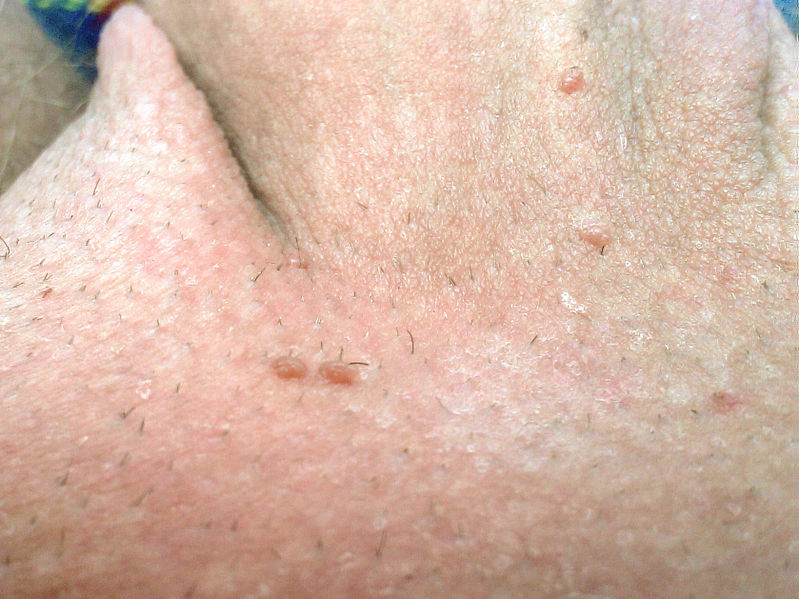
Sexual Health
Question 158 of 180

A 34 year old man presents to the Emergency Department with small painless lumps at the base of his penis. What is the diagnosis?
Answer:
Warts usually present as soft cauliflower-like growths of varying size. Less commonly, they are flat, plaque-like or pigmented. The colour can vary from whitish to flesh-coloured to hyperpigmented to erythematous. They are usually less than 10 mm in diameter, however they may coalesce into large plaques, especially in people with are immunosuppressed, or have diabetes. Rarely, large warts present with secondary infection and maceration.Genital Warts
Sexual Health
Last Updated: 12th February 2021
Anogenital warts (Condylomata acuminata) are benign, proliferative growths occurring in the genital, perineal, anal, and perianal areas. Lesions can also occur in the urethral meatus, vagina, cervix, and anal canal.
Transmission
- Anogenital warts are caused by the human papillomavirus (HPV), most commonly low-risk non-oncogenic genotypes 6 and 11.
- Infection with HPV is through direct skin to skin contact with a person who has clinical, or subclinical HPV, or contact with genital secretions.
- The most common mode of transmission is sexual contact, but anogenital warts may rarely be transmitted perinatally and from hand warts. Orogenital transmission is also possible.
- Infection can also occur from contact with contaminated surfaces or objects.
Diagnosis
- Genital warts are usually asymptomatic, and may be single, or multiple, and tend to occur in areas of high friction.
- Pain may occur if the lesions become friable or are irritated due to local trauma.
- Urinary symptoms, such as terminal haematuria or abnormal stream of urine can indicate lesions in the distal urethra and meatus.
- Bleeding may occur due to local trauma (for example, by underwear).
- On examination:
- Warts usually present as soft cauliflower-like growths of varying size. Less commonly, they are flat, plaque-like or pigmented. The colour can vary from whitish to flesh-coloured to hyperpigmented to erythematous. They are usually less than 10 mm in diameter, however they may coalesce into large plaques, especially in people with are immunosuppressed, or have diabetes. Rarely, large warts present with secondary infection and maceration.
Differential diagnosis
- Pearly penile papules
- Molluscum contagiosum
- Condylomata lata (secondary syphilis)
- Carcinoma in situ
- Other skin conditions: skin tags, seborrhoeic keratoses, epidermoid cysts, sebaceous cysts
Management
- If possible, refer all people with anogenital warts to a sexual health specialist.
- Screening for co-existing sexually transmitted infections (STIs) is essential, particularly in people younger than 25 years of age and those with other genital symptoms.
- Treatment options include:
- No treatment — treatment is not always indicated, as in about 30% of people warts disappear spontaneously within 6 months
- Self-applied treatments
- Podophyllotoxin, imiquimod or sinecatechins
- Specialist application
- Trichloroacetic acid (TCA) 80-90% solution
- Ablative methods
- Cryotherapy, excision or electrocautery
Complications
- Although anogenital warts are caused by low-risk genotypes of human papillomavirus (HPV) HPV 6 and HPV 11, there may be simultaneous infection with the high-risk oncogenic HPV genotypes that are associated with anogenital cancer.
- Anogenital warts may be disfiguring, and cause anxiety or distress.
- Possible complications associated with treatment include:
- Persistent hypo- or hyper-pigmentation due to ablative therapy.
- Hypertrophic scarring.
- Bleeding, infection, or scarring due to surgical removal.
Report A Problem
Is there something wrong with this question? Let us know and we’ll fix it as soon as possible.
Loading Form...
- Biochemistry
- Blood Gases
- Haematology
| Biochemistry | Normal Value |
|---|---|
| Sodium | 135 – 145 mmol/l |
| Potassium | 3.0 – 4.5 mmol/l |
| Urea | 2.5 – 7.5 mmol/l |
| Glucose | 3.5 – 5.0 mmol/l |
| Creatinine | 35 – 135 μmol/l |
| Alanine Aminotransferase (ALT) | 5 – 35 U/l |
| Gamma-glutamyl Transferase (GGT) | < 65 U/l |
| Alkaline Phosphatase (ALP) | 30 – 135 U/l |
| Aspartate Aminotransferase (AST) | < 40 U/l |
| Total Protein | 60 – 80 g/l |
| Albumin | 35 – 50 g/l |
| Globulin | 2.4 – 3.5 g/dl |
| Amylase | < 70 U/l |
| Total Bilirubin | 3 – 17 μmol/l |
| Calcium | 2.1 – 2.5 mmol/l |
| Chloride | 95 – 105 mmol/l |
| Phosphate | 0.8 – 1.4 mmol/l |
| Haematology | Normal Value |
|---|---|
| Haemoglobin | 11.5 – 16.6 g/dl |
| White Blood Cells | 4.0 – 11.0 x 109/l |
| Platelets | 150 – 450 x 109/l |
| MCV | 80 – 96 fl |
| MCHC | 32 – 36 g/dl |
| Neutrophils | 2.0 – 7.5 x 109/l |
| Lymphocytes | 1.5 – 4.0 x 109/l |
| Monocytes | 0.3 – 1.0 x 109/l |
| Eosinophils | 0.1 – 0.5 x 109/l |
| Basophils | < 0.2 x 109/l |
| Reticulocytes | < 2% |
| Haematocrit | 0.35 – 0.49 |
| Red Cell Distribution Width | 11 – 15% |
| Blood Gases | Normal Value |
|---|---|
| pH | 7.35 – 7.45 |
| pO2 | 11 – 14 kPa |
| pCO2 | 4.5 – 6.0 kPa |
| Base Excess | -2 – +2 mmol/l |
| Bicarbonate | 24 – 30 mmol/l |
| Lactate | < 2 mmol/l |

